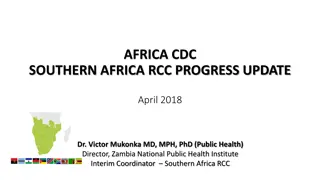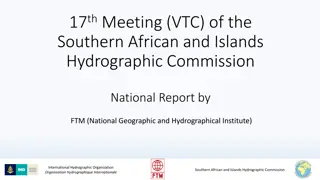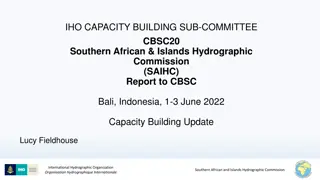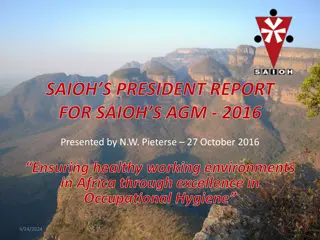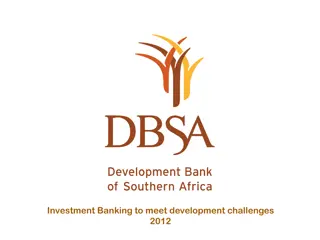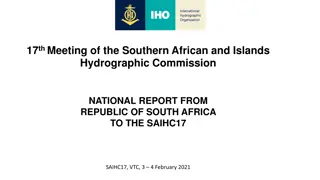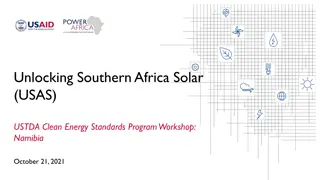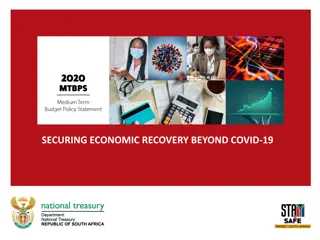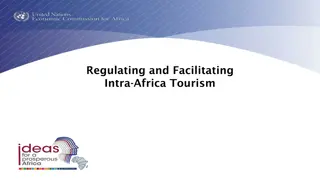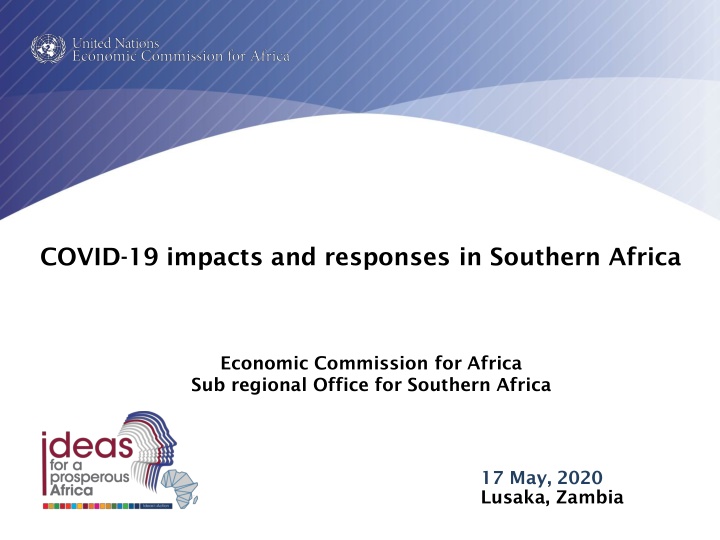
COVID-19 Impacts in Southern Africa: Economic Commission for Africa
This report provides insights on COVID-19 impacts and responses in Southern Africa, including statistics on cases, national strategies, and socio-economic impacts like the contraction of regional economy, debt levels, and food insecurity.
Download Presentation

Please find below an Image/Link to download the presentation.
The content on the website is provided AS IS for your information and personal use only. It may not be sold, licensed, or shared on other websites without obtaining consent from the author. If you encounter any issues during the download, it is possible that the publisher has removed the file from their server.
You are allowed to download the files provided on this website for personal or commercial use, subject to the condition that they are used lawfully. All files are the property of their respective owners.
The content on the website is provided AS IS for your information and personal use only. It may not be sold, licensed, or shared on other websites without obtaining consent from the author.
E N D
Presentation Transcript
COVID-19 impacts and responses in Southern Africa Economic Commission for Africa Sub regional Office for Southern Africa 17 May, 2020 Lusaka, Zambia
COVID-19 Tests, Infections, Deaths & Recoveries in Southern Africa COUNTRY POSITIVE CASES (CUMULATIVE) RECOVERIES DEATHS TOTAL TESTS Angola 48 17 2 6353 Botswana 24 17 1 11945 Eswatini 202 72 2 unavailable Lesotho 1 0 0 unavailable Malawi 65 24 3 1762 Mauritius 332 322 10 86887 Mozambique 137 44 0 6011 Namibia 16 13 0 2381 14355 6478 261 439559 South Africa Zambia 753 188 7 17354 17 Zimbabwe SRO-SA 44 4 27059 599311 15977 7192 290 Source: Ministries of Health Date: 17/05/2020
COVID-19: National Responses and Strategies Country National Response Strategies/Actions Travel Restrictions Fiscal Stimulus Monetary Stimulus Lockdown Mass Quarantine Easing of Lockdown Testing Angola no x no Botswana no x Eswatini no x x Lesotho no x no Malawi no no x NA Mauritius no x no Mozambique no x no Namibia no x South Africa x x Zambia x x Zimbabwe no x x Key: X = affirmation/yes
COVID-19: Socio-economic Impacts Regional economy to contract by 3% in 2020 from the previously expected 3.3% growth in 2019 low commodity prices from slow growth in major markets, South Africa is expected to contract by 6.4%, Botswana by 13.1%, Zimbabwe by 7.4%, Zambia by 3.5%, for example Debt levels expected to increase beyond the 60% threshold to 70% of GDP - was 60.2% of GDP in 2019 Current Account deficit is forecast to widen to about 9% of GDP in 2020 from 5.8% in 2019 High imports of medical supplies will exert downward pressure on exchange rates and reserves reserves were at 5 months cover in 2019 and will decline further; Regional macro economic convergence criteria will be missed due to rising deficits, inflation, debt, etc Even though mines (sector contributes over 10% to regional GDP, 60% to regional exports) have recently re-opened in South Africa and Zimbabwe, social distancing will compromise productivity Overall regional growth Reliance of commodity exports by regional member States, weak commodity prices from the low growth in China, USA and the European Union Disruption of supply chains through reduced access to inputs, closure of ports and trade routes for a highly dependent manufacturing sector - reduction in both exports and imports Low intra-SADC trade at 19.3% in 2019 means trade with the rest of the world is key Services sector accounts for more than 50% of the GDP of most member States decimated by transport challenges, closure of sports, disruption of supply leading to economic contraction MSMEs constitute between 75% and 95% of total number of firms and account for 48% of employment, are key to the SADC Industrialization Strategy will be adversely affected Industry and trade Exacerbation of food and nutritional insecurity across the region, 70% of regional citizens depend on agriculture 15% of SADC population (41.2) million) was food insecure in 2019 Regional per capita energy supply is 2160 Kcal against 2700 Kcal and protein supply at 49g per person per day is lower than the recommended 68g a combination of the adverse weather conditions in the 2019/2020 season and the impact of COVID-19 on farm productivity will worsen food insecurity Food Security and nutrition Sources: SADC Selected macroeconomic indicators (2018/9), SADC Responses to COVID-19, Bulletin No. 3 (2020), COVID-19 in COMESA: Situational Report (2020)
COVID-19: Socio-economic Impacts Informality exceeds 50% in most SADC member States informal cross-border trade is worth an estimated US$18 billion per year, accounting for 30%-40% of intra-SADC trade and 70% of the traders are women disruption by COVID-19 forcing quarantine of traders is a threat to livelihoods from the highly informalized economies In a worst case scenario, South Africa alone may lose 7 million jobs due to the pandemic Employment Regional health system generally weak and could be overwhelmed when the anticipated surge in infections does occur Average ICU beds in SADC is 0.5 per 1000 citizens a threat to dealing with an upsurge in infections needing hospitalizations South Africa has 800 beds per 1000 citizens for its 58 million people However, Southern Africa s youthful population might result in lower fatalities even at the same infection rates as in Europe 17 million people are living with HIV (PLHIV) in SADC (44% of world PLHIV) 6 million are not on ART, hence given the susceptibility to infections, this is a threat to member States health systems also poses a threat to HI, malaria, tuberculosis, etc programming Shortages of healthcare workers, including doctors increases the risk of fatalities when infections occur Critical equipment and supplies shortage sourcing of ventilators, testing kits, beds and masks during a pandemic becomes competitive and costly and , Health Sources: SADC Selected macroeconomic indicators (2019), SADC Responses to COVID-19, Bulletin No. 3 (2020), COVID-19 in COMESA: Situational Report (2020)
SADC Responses to COVID-19 A. Coordinated approach to: i. procurement of medical supplies (equipment and PPEs): through SADC Pooled Procurement Services via respective Medical stores departments; ii. management of border movement: to facilitate smooth quarantine and repatriation of regional citizens seeking to return home; iii. management of traffic across borders ferrying key commodities and medical supplies: 80% of goods (including inputs, fuel, food and medical supplies) across the region transported by road, protocol includes testing for truck drivers; iv. implementation of fiscal and monetary rescue packages and lockdowns; v. sharing information on actions, policies related to reduction of the spread of COVID-19 by all modes of transport; vi. formulation national policies, regulations & guidelines & establish institutions for law enforcement and monitoring, screening & quarantining & medical treatment of drivers, pilots & crew members; vii. suspension of inter-State mass movement of persons by buses/minibuses or other vehicles for specified periods; and viii. re-establishment of Technical Committee to support a coordinated regional approach for dealing with pandemics. B. Adoption of Regional Resilient Strategic Framework (2020-2030) and implementation of the Preparedness and Response and Disaster Fund and operationalization of the Regional Development Fund Consolidating a regional approach to fighting COVID- 19 infections and spread
SADC Responses to COVID-19 C. Coordination of transit facilitation through: i. removal of restrictions on cross border cargo vehicles for food; medical equipment, medicines, supplies, ppe, fuel & coal; agricultural inputs & supplies; chemicals, packaging, equipment, spares, maintenance materials; inputs for production & processing of food products; and security, emergency & humanitarian relief services; ii. simplification & automation of trade & transport facilitation processes; iii. introduction/enhancement of pre-clearance of goods & single window processing; and iv. acceleration of creation of e-applications & platforms for handling imports & exports, application, issuance & renewals of licences, permits, registration of drivers, operators, vehicles & loads, payment of fees; and, information dissemination & sharing. D. Scaling up the development of regional value chains beginning with the pharmaceuticals, mining and agro-processing as part of the implementation of the SADC Industrialization Strategy and Roadmap, supporting MSMEs to anchor Sources: SADC Selected macroeconomic indicators (2019), SADC Responses to COVID-19, Bulletin No. 3 (2020), COVID-19 in COMESA: Situational Report (2020)





